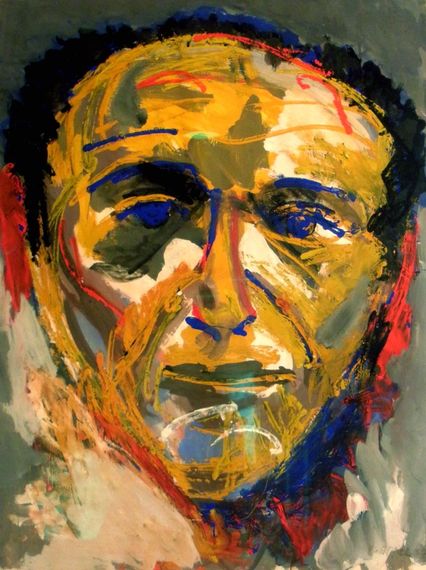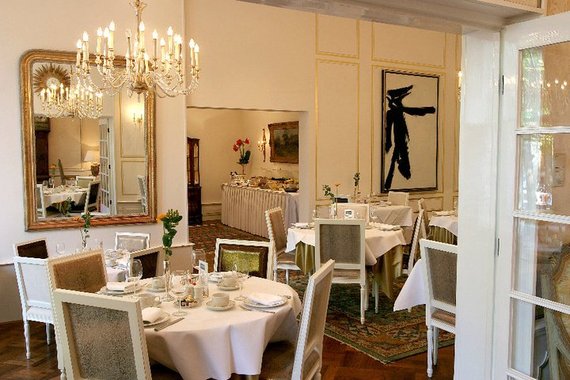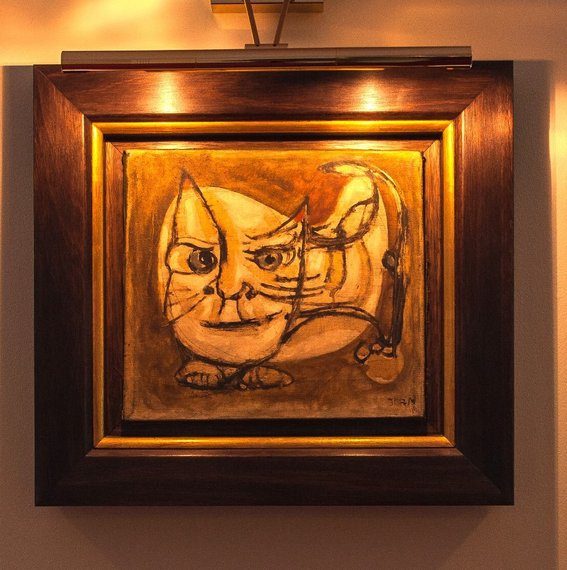Amsterdam's Ambassade Hotel must rank at or near the top of any listing of art hotels. Its collection is vast -- hundreds of original paintings, drawings, and sculptures, displayed not only in the hotel's public rooms but also in all of its guest rooms -- and of extremely high quality. And now the Ambassade has something that may be unique among art hotels: a published catalogue of its art.
 |
Karel Appel, Portrait of Theo Wolvecamp (1957). All images courtesy of the Ambassade Hotel, Amsterdam. |
The Ambassade's art collection began in 1988, when the hotel's owner, Wouter Schopman, visited an exhibition titled "Cobra, 40 Years After," in Amsterdam's Nieuwe Kerk. For Schopman, it was love at first sight, "like a bolt out of the blue. Suddenly my breath was taken away by the sight of all these amazing things: the colors, the freedom, the playfulness, the unconventional, the experiment, the intuitive." He immediately respected the artists: "Remarkable, these daring artists in such a strait-laced formal era. That's what I admire so much about them: their courage." Schopman soon began buying Cobra art. Interestingly, however, he could not hang it in the Ambassade, because the hotel's older and more conservative co-owner felt Cobra was inconsistent with the hotel's traditional architecture. But in 2000 Schopman bought out his partner and became sole owner of the Ambassade, and his Cobra collection took over the hotel.
 |
Ambassade Hotel on the Herengracht, at night. |
Cobra was a revolutionary art movement that had a brief but intense career. It originated in Paris in 1948, when a number of radical young artists from northern Europe formally pledged their allegiance to a collective enterprise, which they named for their home cities - COpenhagen, BRussels, Amsterdam. Cobra echoed the earlier movement of Dada in a number of respects. Like Dada, Cobra had no coherent philosophy, and was not tied to specific products or practices. Like Dada, Cobra was a loose alliance of young writers and painters, who wanted to break away from the conservative restrictions and traditions of the existing art world: as the Dutch artist Constant explained, "There is no Cobra style and no Cobra aesthetic...L'esprit Cobra is the spirit that rebels against limitations, the spirit of freedom." The young rebels of Dada were appalled by the butchery of World War I, those of Cobra by the horrors of World War II. Formally, Cobra lasted only three years. Many of Cobra's members went on to long and successful careers, but for most of them, the most creative time of their lives was the brief span when they belonged to Cobra.
 |
Theo Wolvecamp's Gabriel on display inside the Ambassade Hotel, Amsterdam. |
Cobra's art had many sources. Most of the Cobra artists wanted to achieve the spontaneity and simplicity of children's drawings. They also admired Kandinsky's colors, Klee's draftsmanship, Miro's fantastic imagery, and Picasso's stylistic versatility. Although Cobra artists did not share a common style, their work generally bears a family resemblance, with bright colors, bold outlines, and subjects that often hover between representation and abstraction, and between realism and fantasy; their art almost always displays the energy and intensity with which it was produced.
CoBrA aan de gracht/CoBrA on the Canal is a book about the art and artists in the Ambassade Hotel's collection. Its text, by the art scholar Esther Schreuder, includes a brief account of the formation of the collection, a history of the Cobra movement, and individual profiles of nearly two dozen artists who are represented in the Ambassade's collection. The text is particularly interesting because Schreuder consistently emphasizes the artists' own viewpoints, using their own words to describe their personal histories, their artistic goals, and their experiences in Cobra. She also integrates the artists' biographies with the art in the hotel's collection. So for example among the book's many fascinating insights is the account of Jacqueline de Jong, the former girlfriend of Asger Jorn, instantly recognizing Jorn's painting, Watch Cat, as a self-portrait of the artist, when she visited the Ambassade.
 |
Asger Jorn, Untitled (The watch cat), 1949. |
CoBrA on the Canal profiles all the central figures in Cobra, including Karel Appel, Pierre Alechinsky, Constant, Corneille, and Asger Jorn. The book is beautifully produced, with hundreds of photographs and illustrations that bring the art of Cobra to life. It devotes particular attention to the Dutch painter Theo Wolvecamp, whose art is the greatest strength of the Ambassade's collection. Wouter Schopman became a friend of Wolvecamp before the death of the latter in 1992, and bought major works from the artist and his heirs: the Ambassade owns more than 500 works by Wolvecamp, in what must certainly be the best collection of his art in existence. Wolvecamp was much less famous, and less flamboyant, than his close friend Karel Appel, but his art is exceptionally beautiful. Wolvecamp was in many respects an outlier in Cobra, for he was an experimental artist in an overwhelmingly conceptual movement. His mature work recalls the abstraction of Jackson Pollock and Franz Kline. One of the great pleasures of visiting the Ambassade is the opportunity to discover this relatively neglected artist.
 |
Theo Wolvecamp, Unititled (1972). |
The Ambassade Hotel is housed in eleven seventeenth-century houses on the elegant Herengracht Canal. These staid and dignified houses were built by the great merchants who dominated the prosperous economy of Holland in its Golden Age. These merchants were surely as staid and dignified as the simple and tasteful houses they built. There can be little doubt that these conservative merchants would have been horrified by the bold and bright Cobra paintings of ghosts, dragons, and other imaginary spirits that today hang in their old houses. But the beautiful canal houses of the Golden Age in fact serve as a superb setting for the beautiful fantasies of a group of young and radical artistic rebels of the late 1940s. Anyone who visits the Ambassade Hotel today can enjoy this synergy of art and architecture firsthand, and reflect on the tolerance of individualism and freedom that modern Holland represents. Visiting the Ambassade is the best way to have this experience. But now, with CoBrA on the Canal, anyone can enjoy the chaotic creativity of Cobra in its native habitat, even without visiting Amsterdam. Art lovers will be grateful to Wouter Schopman and Esther Schreuder for this opportunity.